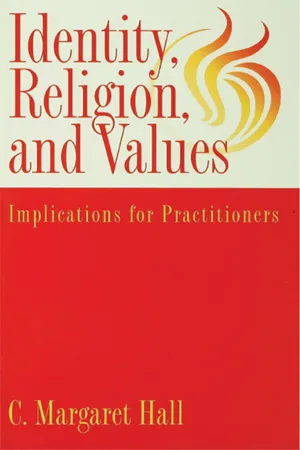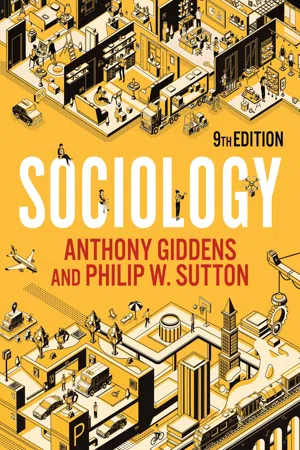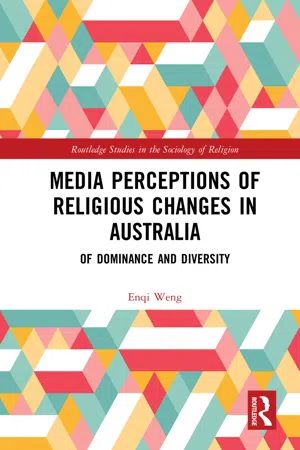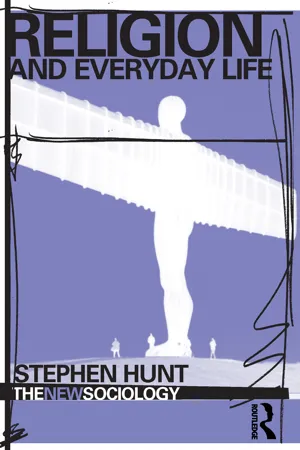History
Religious Change
Religious change refers to the transformation of religious beliefs, practices, and institutions over time. It can be caused by a variety of factors, including social, political, and economic changes, as well as the influence of new ideas and religious movements. Religious change has played a significant role in shaping the course of human history.
Written by Perlego with AI-assistance
Related key terms
7 Key excerpts on "Religious Change"
- eBook - ePub
Indentity, Religion And Values
Implications For Practitioners
- C. Margaret Hall(Author)
- 2013(Publication Date)
- Taylor & Francis(Publisher)
Chapter 10Social Change and ReligionHistorically, religions have served as both conservative forces and catalysts for change. In their capacities as repositories of meanings, religions can motivate large numbers of individuals—even whole populations—either to sustain traditions or to reformulate goals and ideals and do things differently (Lenski, 1951). Moreover, it is only through using a broad historical perspective that people can sufficiently understand the depth and scope of religious influences, and the strength of their impact on the quantity and quality of social life and social change (Ashbrook, 1993).Religious differences have caused violently destructive battles in many times and places (Eisler, 1987). This destruction is linked to religions because abstractions and rigidities in belief systems frequently generate dogmas that provoke disputes and conflicts (Finke & Stark, 1992). It is this kind of bigotry that accentuates religious differences so much that they become irretrievably contradictory and incompatible, with the result that national and international disagreements may escalate into overt conflict and warfare (Eisler, 1987; Lerner, 1986).Religions can be thought of as consisting of those beliefs that are both individually and socially experienced as sacred (Wuthnow, 1992). Although it is crucial to forge identities through basing actions on uniqueness, and through expressing specific values of meaningful groups, there is also a point at which it is important deliberately to identify with the whole human race. For example, although it may be meaningful to identify with all women, it is also morally significant to conduct behavior according to membership in humankind. Although many people realize that there is no escape from the human condition, and that biology knows few cultural or status differences, these universal characteristics and realities have to be actively acknowledged for people to identify with the whole human race. Even where nation states no longer completely define citizens’ everyday circumstances, as they did in the 18th century, awareness of their membership in the world community must be cultivated—an awareness that in fact is facilitated by modern scientific and technological advances (Appleyard, 1993). Group moral agencies such as religions or even political parties may be prime movers of change, but individuals and groups must recognize and accept their responsibilities for the implementation and consequences of the particular changes they initiate. - eBook - ePub
The Pastor in a Changing Society
Effects of Social Change on the Role of the Pastor in Africa
- Kinyamagoha(Author)
- 2014(Publication Date)
- Resource Publications(Publisher)
According to Knitter, the face of the Church started to change since the first society started to move. The movement of Judaism into the Greco-Roman world affected everything that Christianity possessed, inclined, and adhered. The social movements affected liturgies, sacramental practices, rituals, organizational and legislations structures with their policies, and doctrines. One may presume that, the cultic impressions of moving seem a non–stop practice. Consequently, as the movement takes place, there happens the change and reshaping of congregations with their roles and practices. The social movement strongly influences while changing even the religious traditions. In supporting this argument, Ellingson states that:Religious traditions, like many other cultural objects, are not static but are constantly in flux. Most explanations of Religious Change start from the premise that rituals, theologies, or congregational cultures, like other forms of culture, are relatively stable and do not change until social structures or cultures outside the religious organization change. This is the fundamental premise . . . on culture, action, and change: ideologies and cultural repertoires do not change until the social world becomes unstable, and when this happens individuals and groups are compelled to rework their cultural repertoires or create new ideologies because the “unsettled times” or social crises have rendered the old meanings and practices obsolete. . . . While external social forces influence Religious Change, they do not necessarily catalyze change as directly as the literature. Traditions change in part because large social forces outside the tradition impinge on our ways of thinking and acting outside the doors of the church. . . . Congregations must decide collectively that the new context is relevant and thus requires some response.416This quotation as well gives a picture of how social movements are very affective to church theories and practices. External social forces have powerful influences over religion with its traditions. It means that, society can change everything depending on its needs, demands and interests. The same happens if society gets into crises or into unsettled times, its impacts affects the Church and all religious practices. The opposite also may be, the stable society, is the stable the church (religion). - eBook - ePub
SUNY series in Western Esoteric Traditions
The Panacea Society in the Twentieth Century
- Alastair Lockhart(Author)
- 2019(Publication Date)
- SUNY Press(Publisher)
CHAPTER THREEUnderstanding Religion
The classic historiographical and sociological claim about the nature of Religious Change amid the modernization of societies has been understood as a claim about the decline of religion—the secularization thesis. In line with recent ideas about this thesis, which query the validity of the inherent teleology of the notion and seek instead to understand Religious Change as being made up of lived social and spiritual processes, this chapter analyzes and assesses a range of formulations of the theory. It suggests that while classic theorists may have been presented as predicting and describing the ultimate demise of religion, an attentive reading of many of these authors’ texts identifies how religion is explicitly presented as persisting in some way. After establishing the core point, that theses of secularization have not inherently excluded the continuation of religion into the future, the chapter proposes a framework for employing a revised secularization thesis as a method in the study of contemporary religiosity, and especially those forms that are generally understood to be characteristically recent developments: flexible and individual forms in dynamic and noninstitutional contexts. In the framework of the Society’s extraordinary global reach, its accessibility to people of all faiths and across all backgrounds, and its chronological spread across the twentieth century, the letters of the Panacea Society’s healing users are a valuable resource for a study using the methodology proposed.THEORIES OF Religious Change
There is a longstanding tradition of sociological analysis and conventional wisdom that has perceived a more or less inevitable process of religious decline in modern cultures, especially in those where Christianity has been the dominant mainstream religion. The historian Hugh McLeod, for example, lists a canon of sociologists who “shared a commitment to the ‘secularization thesis’ … that the dwindling social significance of religion is an inevitable consequence of the process of social development in modern societies.”1 Anthony Carroll has observed that “secularization has been, until recently, an uncontested motif of accounts of modernity” and that “for much of the twentieth century, the theory of secularization was a cultural a priori that informed all thought about the modern world and its emergence from the medieval past.”2 Classic accounts of the dynamics implicated in secularization theory, such as Peter Berger’s Social Reality of Religion, describe “the process by which sectors of society and culture are removed from the domination of religious institutions and symbols” with a concomitant process for individual consciousnesses so that “the modern West has produced an increasing number of individuals who look upon the world and their own lives without the benefit of religious interpretations.”3 A number of contemporary scholars have found evidence to confirm the paradigm. Perhaps the strongest protagonist for secularization as a fundamental theoretical tool for the understanding of Religious Change presently is Steve Bruce. Bruce notes an ebb and flow of religious influence in Europe over a long period but detects decline overall and finds no historical case where there has been a “reversal of decline.”4 - eBook - ePub
- Anthony Giddens, Philip W. Sutton(Authors)
- 2021(Publication Date)
- Polity(Publisher)
Various theories have been advanced to explain the popularity of new religious movements. Some scholars have argued that they should be seen as a response to the process of liberalization and secularization. People who feel that traditional religions have become ritualistic and devoid of spiritual meaning may find comfort and a greater sense of community in smaller, less impersonal religious movements. Others point to new religious movements as an outcome of rapid social change (Wilson 1982). As traditional social norms are disrupted, people search for both explanations and reassurance. The rise of groups which emphasize personal spirituality, for example, suggests that many individuals feel a need to connect with their own values or beliefs in the face of instability and uncertainty.New religious movements are one recent development, but not the only one. In many national contexts, religious beliefs and practices have undergone changes as a result of fresh challenges such as the development of religious fundamentalism, globalization and multiculturalism, internal movements for gender and sexuality equality, and, of course, secularization. The next section traces some of these shifts, focusing on Europe and North America.Contemporary religion: trends and challengesIn global terms, religions, religious beliefs and religious practices today are increasingly diverse, making generalizations about the fate of ‘religion’, as such, unwise. With this in mind, the final part of the chapter presents some significant trends and challenges faced by religions under conditions of globalization.Christianity, gender and sexuality
Elizabeth Cady Stanton (1815–1902), an American campaigner for women’s rights, argued that the deity had created women and men as beings of equal value, and the Bible should fully reflect this fact. Its ‘masculinist’ character, she believed, reflected not the authentic word of God but the fact that the Bible was written by men. When a colleague opened a women’s rights conference with a prayer to ‘God, our Mother’, there was a fierce reaction from church authorities. Yet she pressed on, organizing a Women’s Revising Committee in America, composed of twenty-three women, to advise her in preparing The Woman’s Bible - eBook - ePub
Media Perceptions of Religious Changes in Australia
Of Dominance and Diversity
- Enqi Weng(Author)
- 2019(Publication Date)
- Routledge(Publisher)
The second critique highlights the fact that certain aspects of the secularisation thesis remain true. It is therefore argued that only a revision of the theory is required. The first consideration for this critique is that the secularisation thesis is predominantly a Western issue since it emerged out of a Western context. Therefore, it was never meant to be and cannot be viewed as a universal concept (Bruce, 2002: 37; Partridge, 2004). In other words, the thesis is best viewed as a ‘response and reaction to the particular medieval Latin Christian system of classification of all reality into spiritual and temporal, religious and secular’ (Casanova, 2012: 27), and is relevant where a society recognises the cultural prioritisation of ‘rationalism’ (Morozov, 2008: 41). One suggested revision to the thesis is to focus on the irreversibility of the process—that when ideologies, meanings, functions and things shift from a religious sphere to a secular one, it is highly unlikely that it will return to a religious perspective (Bruce, 2002: 38). However, there are little clarifications on why such a process can only be mono-directional. The second consideration for this critique is that the global mass mobility of people, culture and ideas has reshaped the cultural contours, especially of Western countries where the secularisation thesis has primarily been observed (Herbert, 2012: 94). This means that the thesis still holds in the Western context, but its religiosity has been reshaped due to mass migration influences.A third position has since emerged that focuses on religion in its constant state of flux. It argues that religion continuously negotiates with its sociocultural context and as such, it evolves, transforms and diversifies in its beliefs, meanings, symbols and practices that translate into its longevity. For instance, Religious Changes in Britain have led to its increased public visibility through works of services from the late 1990s (Beckford, 2012: 13). This ongoing change is transpired by ‘a shift in the institutional location of religion … rather than secularization’ (Berger, 1999). Consequent to these changes, numerical indexing of religiosity through affiliations and attendance will not present a full picture of the British religious condition. Academic interests have more recently turned towards the study of religion through the media, based on an understanding that religion has embodied social practices, and continuously negotiates with and adapts to its social and cultural situations. The breadth of this religion–media interface will be considered in the next chapter. The next section will first outline new perspectives on defining religion and terms that have been used in its association.New perspectives
Having demonstrated critiques against the dominant secularisation thesis in light of the new visibility of religion in the contemporary world, this section will examine how religion is currently understood and defined, as well as the terms associated with it. It then explores a sociological turn in the use of the concept of the sacred to rethink religion from a broadened perspective. - eBook - ePub
- Tim Allen, Tracey Skelton(Authors)
- 2005(Publication Date)
- Routledge(Publisher)
Because of the importance placed here on the explanatory value of the role of modernisation, it may be appropriate at the outset to say a little about it. Throughout the Third World, with the important exception of post-revolutionary states such as China and Iran, the general direction in which social change has taken place is usually referred to as either ‘modernisation’ or ‘Westernisation’. That is, social change is understood to lead to significant shifts in the behaviour and prevailing choices of social actors, with such particularistic traits as ethnicity or caste losing importance in relation to more generalistic attributes such as nationalism. Growth of formal organisations (e.g. political parties) and procedures (e.g. ‘the rule of law’), it is claimed, reduces the central role of clientelism and patronage. In short, some believe that the advent of social change corresponding to a presumed process of modernisation would lead to a general jettisoning of older, traditional values and the adoption of other, initially alien, practices. In many respects, however, the adoption of Western traits in many Third World states is rather skin-deep: Western suits for men rather than traditional dress; the trappings of statehood – flag, constitution, legislature, etc.; a Western lingua franca, and so on. The important point is that social change will not be even throughout a society; social and political conflicts are highly likely owing to the patchy adoption of modern practices. Social change destabilises, creating a dichotomy between those who seek to benefit from wholesale change and those who prefer the status quo. New social strata arise whose position in the new order is decidedly ambiguous. Examples include recent rural-urban migrants in Middle Eastern, African, Latin American and other Third World societies, who find themselves between two worlds, often without an effective or appropriate set of anchoring values. Such people are particularly open to political appeals based on religious precepts (Haynes 1993).Generally, religion is an important source of basic value orientations. It may have a powerful impact upon politics within a state or region, especially in the context of ethnicity, culture or fundamentalism. Ethnicity relates to the shared characteristics of a racial or cultural group. Religious belief may reinforce ethnic consciousness and inter-ethnic conflict, especially in the Third World (but not only there: think of Northern Ireland or former Yugoslavia). Religious fundamentalism, on the other hand, connotes a ‘set of strategies, by which beleaguered believers attempt to preserve their distinctive identity as a people or group’ in response to a real or imagined attack from those who apparently threaten to draw them into a ‘syncretistic, a religious, or irreligious cultural milieu’ (Marty and Scott Appleby 1993: 3). Sometimes such defensiveness may develop into a political offensive which seeks to alter the prevailing social, political and, on occasions, economic realities of state-society relations.The Political Significance of IdentityPrecisely how ethnic and religious conflicts relate to development is not clear, although ‘the differential outcome of both growth and stagnation must obviously have an impact’ (Hettne 1995: 6). Social, political and economic change in the Third World comes about as a result of a complex interaction of both domestic and external developments over time. The contemporary political importance of ethnicity and religion is what Habermas (1976) regards as an integral facet of wider Third World ‘identity crises’, i.e. serious threats to national integration and to the process of economic development, which focus on the existence of ‘cleavages’ within societies. - eBook - ePub
- Stephen Hunt(Author)
- 2013(Publication Date)
- Routledge(Publisher)
1CONTEMPORARY RELIGION
CHANGING DEFINITIONS
DEFINITIONS OF RELIGION
The matter of the nature and significance of religion in contemporary Western societies, and debates regarding possible decline or resurgence, open up broader questions regarding its definition which, in turn, relate to on-going ideological debates as to the merits or otherwise of religious life. In terms of definitions, the sociology of religion faces a unique set of conceptual difficulties which are enhanced by the increasing variety and ever-changing expressions of religiosity, especially their apparent increasing reduction to the individual and privatized level. Thus, only when it is defined can religion be delimited in terms of the subject matter, the trajectories of its transformation understood, and the conjecture that certain forms are experiencing growth, be put in rightful perspective. This is an important endeavour, especially in relation to current sociological theorizing which departs so radically from the conventional secularization thesis.To be sure, the human capacity for belief is seemingly endless, and in Western societies today there would appear to be a vast range of belief systems, some very loosely articulated. Alongside mainstream Christianity are the world religions or a particular tradition of them as embraced by many ethnic groups, one variety or another of fundamentalism, New Religious Movements and those not so new, and the diverse New Age phenomenon and related forms of spirituality. To these might be added the ‘implicit’ or ‘quasi’ religions — those social phenomena which are ‘like’ religions in some way but which may not include all the usual attributes and perhaps may not even be accepted as a ‘religion’ by participating social actors. Such diversity renders a discussion of religion, especially at the level of everyday life, a demanding challenge. To some extent this is because it is virtually impossible to differentiate between what is ‘in’ and what is ‘out’, that which can correctly be called religion and that which cannot. This is compounded by the problem of measuring the impact of religiosity at the everyday level — a problem further accentuated by the changing cultural perception of the word ‘religion’ itself. Put succinctly, the term appears to have gone out of vogue, with ‘spirituality’ often being preferred, not least of all by those who themselves seek to indulge in new forms.
Index pages curate the most relevant extracts from our library of academic textbooks. They’ve been created using an in-house natural language model (NLM), each adding context and meaning to key research topics.






